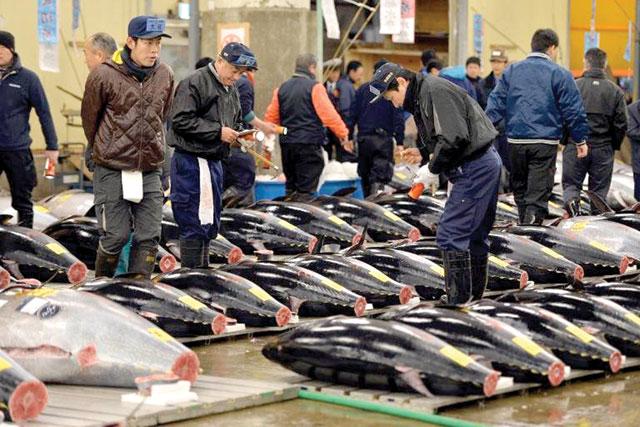You are here
Sushi alert: Grim outlook for bluefin tuna
By AP - Apr 20,2016 - Last updated at Apr 20,2016
TOKYO — The latest scientific assessment paints a likely bleak future for the Pacific bluefin tuna, a sushi lovers’ favourite whose population has dropped by more than 97 per cent from its historic levels.
A draft summary of a report by the International Scientific Committee for Tuna and Tuna-like Species in the North Pacific Ocean seen by The Associated Press shows the current population of bluefin tuna is estimated at 2.6 per cent of its “unfished” size. A previous assessment put the population at an already dire 4.2 per cent.
Overfishing has continued despite calls to reduce catches to allow the species to recover. In some areas, bluefin tuna is harvested at triple the levels considered to be sustainable.
“The situation is really as bad as it appears,” said Amanda Nickson, director for Global Tuna Conservation at The Pew Charitable Trusts.
Limits imposed after the previous estimates actually allowed some countries to up their catches, she said.
“If those managers again fail to act in a conservation-minded way this time, it may be time for other actions, such as an international trade ban or complete fishing moratorium,” Nickson said.
The independent scientists who compiled the report said improved data make them more confident in their latest estimates than in previous ones. The report is due to be reviewed by the committee in July.
The report estimated that in 2014, the total recruitment level of the fish, or the percentage of new fish that survive each year, was below 3.7 million fish, the second lowest level ever.
Under current levels of reproduction and management of the fisheries in the Pacific, the likelihood of rebuilding stocks to healthy levels is only 0.1 per cent, the report says.
Cutting catches by a fifth would improve those odds to only 3 per cent.
Japanese eat about 80 per cent of all bluefin tuna caught worldwide, and stocks of all three bluefin species — the Pacific, Southern and Atlantic — have fallen over the past 15 years as demand for the luscious, buttery pink-to-red fleshed fish has soared globally.
Organisations charged with helping to manage bluefin fisheries have set a goal of rebuilding the species’ population to 6.4 per cent, or 42,592 metric tons, of unfished levels by 2024.
But 6.4 per cent levels for a species like the Pacific bluefin, which can live for up to 40 years, are no guarantee of a recovery. Many experts believe 20 per cent of historic levels is the minimum size for a sustainable fishery.
The international body that monitors fisheries in most of the Pacific Ocean, the Western and Central Pacific Fisheries Commission, was unable to reach consensus last year on either short-term or long-term measures to help restore the bluefin population.
In Europe, officials have agreed last month on implementing a recovery plan for bluefin tuna in the eastern Atlantic and the Mediterranean.
A next step by conservationists could include efforts to get Pacific bluefin tuna banned from international trading.
Related Articles
The Pacific bluefin tuna, a fish used in sushi and sashimi dishes, is at risk of extinction as the global food marketplaces “unsustainable pressure” on the species and others, a conservation body recently warned.
SAN DIEGO — Tuna caught in industrialised areas of the Pacific and Atlantic oceans have 36 times more pollutants than those fished in remote
Fish in the Northeast Atlantic — including cod, the prime ingredient in fish-and-chips — saw a dramatic drop of 34 per cent in the past seve














